Index

Review: 100% custom R9 295X2 design
Today we will be playing around with AMD’s most powerful graphics card, courtesy of PowerColor. Oddly enough, PowerColor is not using standard R9 295X2 branding for its dual-GPU card. It calls it the Devil 13 Dual GPU R9 290X. The marketing plan is simple – PowerColor wants to differentiate its dual-Hawaii card from the rest of the field.
It is not just the branding, though. The PowerColor card features a 100% custom design with a triple-slot air cooler and a custom PCB with 10+3+2 power phases and four 8-pin connectors. Under the bonnet the Devil 13 is essentially identical to the R9 295X2, as it features two Hawaii XT GPUs on a single PCB.
The PowerColor Devil 13 Dual GPU card is not easy to find in European retail and therefore it is quite a bit pricier than the reference card. On average you are looking at about €1,330 in Europe, which is €130 more than the reference card. However, in terms of value it is still an interesting proposition. The card ships with a bundled Razer Ouroboros gaming mouse, which costs about €130 on its own.
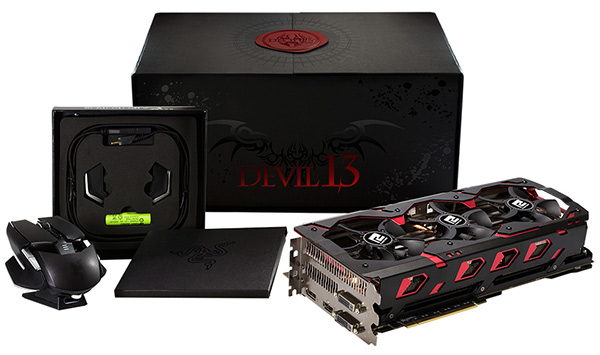
It is no secret that AMD went for world beating performance with the R9 295X2, hence there was not a lot of emphasis on power consumption. AMD pulled out all the stops with the 295. The card has a TDP of 500W and AMD’s power target for each individual GPU is 208W. For example the old HD 7990 had a TDP of “just” 375W, while a single R9 290X card boasts 250W. The PowerColor card can go even higher once you overclock it.
Each of the Hawaii XT GPUs has 2816 Stream Processors and 64 ROPs enabled. The 28nm die measures 438mm2 and it houses 6.2 billion transistors. It is AMD’s biggest GPU to date and the dual-GPU R9 295X2 card can churn out 11.5 TFLOPs of compute performance.
Compared with the dual-GPU HD 7990 based on the old Tahiti core, the new card delivers a 40 percent performance gain in shading and texturing. The ROP throughput has been doubled, the memory capacity was increased by 33 percent and the bandwidth went up by 11 percent. Each GPU on the card has 4GB of GDDR5 at its disposal. The memory is clocked at 5GHz effective. Operating on a 512-bit memory bus, this translates into 320GB/s bandwidth per GPU.
Previous generations of AMD’s dual-GPU cards used to ship with slightly lower clocks than their single-GPU cousins. However, the R9 295X features two top-tier Hawaii XT GPUs clocked somewhat higher than on reference R9 290X cards, 1018MHz vs. 1000MHz.
The GPU was not crippled in any way and performance should be similar or nearly identical to two R9 290X cards in Crossfire.
PowerColor also boosted the memory clocks by 100MHz, so the PowerColor Devil 13 offers somewhat higher performance than the reference card out of the box. The memory is clocked at 1350MHz. This bumps the bandwidth up to 346GB/s, which is about 8 percent more than you’d get on a reference R9 295 X2 card.
Bear in mind that PowerTune regulates the GPU clock, which means there is no longer a fixed clock. The 1018MHz clock is the highest clock and usually you will see somewhat lower clocks. In most cases the card throttles down to stay within the thermal envelope. AMD’s clock management technology is similar to Nvidia’s Boost auto-overlocking feature. It uses thermal and power headroom to utilize the GPUs in the best possible way.
AMD was not willing to take many chances with the R9 295X2 cooling system, so it reached a deal with Asetek. In turn Asetek provided the card with a closed-loop liquid cooler with a radiator. This way AMD provided the card with a good cooler without wasting too much face. Keeping a 500W card cool was never going to be easy.
As for PowerColor, it decided to change the basic design and equip the card with a triple-slot air cooler. Hopefully the cooler should not have a problem of keeping two GPU clocks at the maximum during extended intensive GPU load scenarios. We will check whether it can provide overclocking headroom for the Devil 13 card.
GPUZ confirmed the Devil 13 Dual GPU R9 290X runs at 1000MHz and we can see that the GDDR5 is working at 1350MHz clock.
The Dual GPU R9 290X card comes in special packaging with a few gifts thrown in. The box is very large, but that is quite common for ultra-high end kit. PowerColor and Razer teamed up and bundled the Razer Ouroboros gaming mouse with the Devil 13. This card is also eligible for AMD's Never Settle promotion, which means buyers get three free games.
In the box you’ll find:
- Manual
- Driver DVD
- two6-pin to 8-pin power cables
- Razer Ouroboros gaming mouse
- PowerJack card supporter, 235mm long. It will prevent warping and/or bending of the 2.34 kg heavy Devil 13 card under its weight, and prevent that the card might put too much pressure on the PCIe slot. The PowerJack is placed at the bottom of the chassis and it supports the graphics card.

Since PowerColor opted for an air cooler, it had to use a big one. This is a 500W card and the cooler is a massive triple-slot affair. The Devil 13 is an all-custom design. The dimensions are (L) 304.8mm x (H) 136.2mm x (W) 59mm. It goes without saying that the card will have to be secured well, which is why the company bundles the PowerJack.
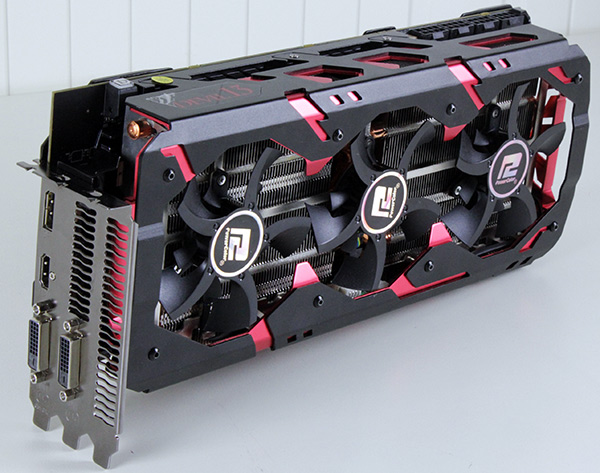
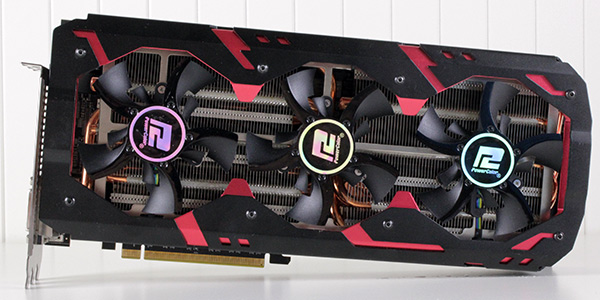
The top of the card is quite attractive thanks to the differently shaped shroud in red and black and of course there is the Devil 13 backlighting which glows in red color and slowly pulsates. The shroud is open on all sides and the openings serve as exhaust vents.

The Devil 13 Dual GPU R9 290X needs four 8-pin power connectors, which, coupled with PCI-Express power, provides up to 675W of power. 
The Devil's 'D' button is actually the BIOS switch connector. The old Devil 13 HD 7990 had a “turbo switch button” which would overclock the GPU by 8 percent. However, the GPU clock on the Devil 13 is set at 1000MHz and it does not change when the ‘D’ button is engaged. The button now acts as a fan booster. Users can manually override the fan control and increase the RPM by 20% with a simple push of the button. This will generate a bit of noise, but at the same time it will allow the card to maintain the maximum 1000MHz clock.
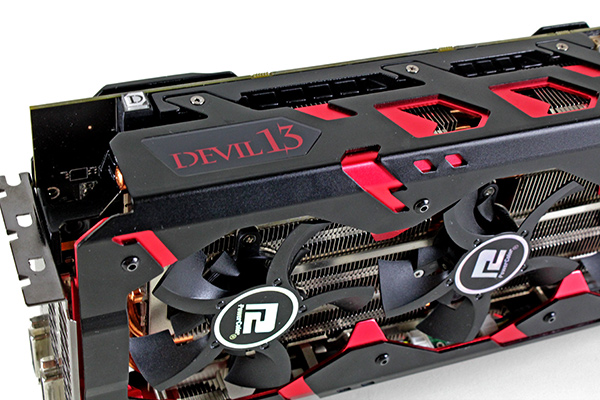
A Crossfire bridge is no longer needed, because the data will be moved over the PCIE.
We already had a chance to try out the old Devil 13 Dual GPU HD 7990 and we were taken aback by its weight. The new Devil 13 card is even heavier, as it weighs 2.34kg compared to the HD 7990’s 1.77kg. The card has a bigger dissipation surface, more copper and two metal frames to keep it all together.
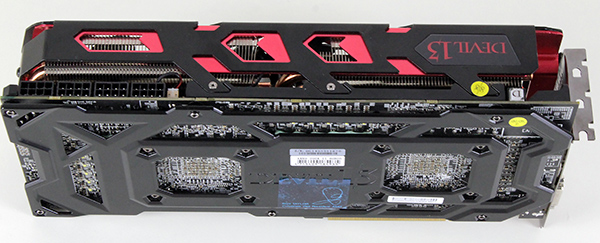
The backplate looks very good indeed. It is a nice change compared with traditional flat backplates. The backplate features a few openings around the GPUs and other components that generate a lot of heat. This means hot air will not be trapped behind the backplate.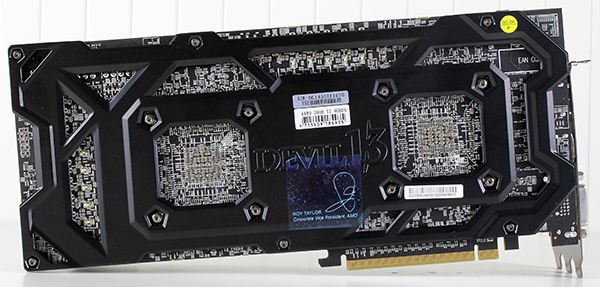
The main function of the backplate is of course to secure the card and make it stable, while looking good in the process. We liked the engraved Devil 13 logo, but we have no clue why Roy Taylor’s autograph is there.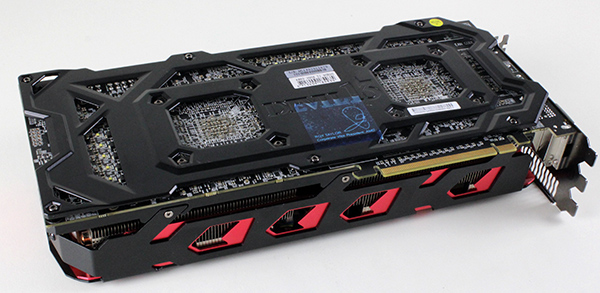
On the back of the card are 5 LEDs per GPU power circuit that display the power status.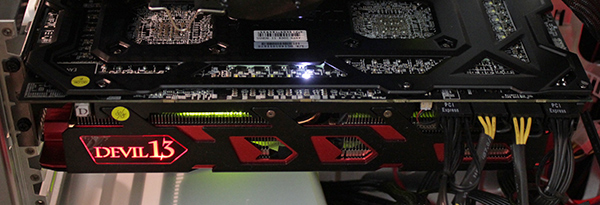
There are three specially shaped 85mm fans and the double bladed fans look rather unusual. PowerColor claims the double-blade design can focus airflow into the center and increase airflow by up to 20 percent compared to traditional fan designs. The design is also supposed to prevent dust from depositing at the bottom. We would still advise users to clean the heatsink on a regular basis. Luckily that is easy to do. You can remove only the fans simply by undoing three screws that keep them attached to the frame.
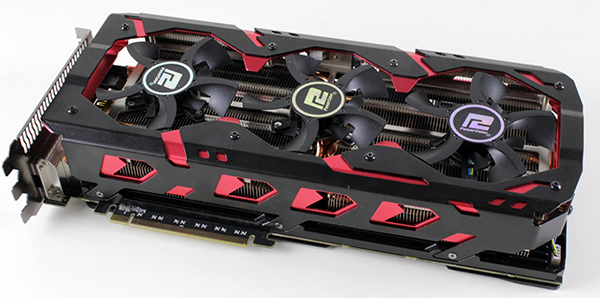
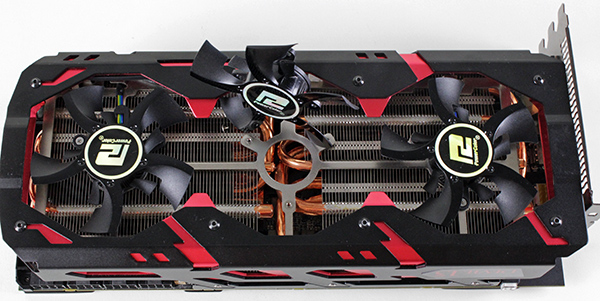
You can see the double bladed design in a bit more detail in the next set of pics.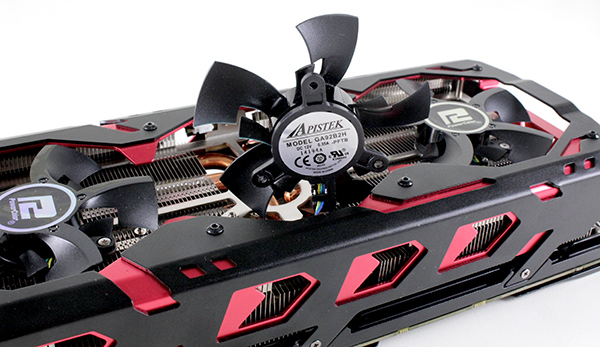

All the fans are connected to the PCB via 4-wire cables. Fan RPM can be regulated via Catalyst Overdrive.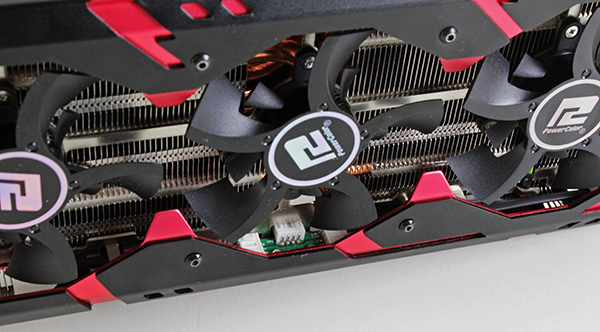
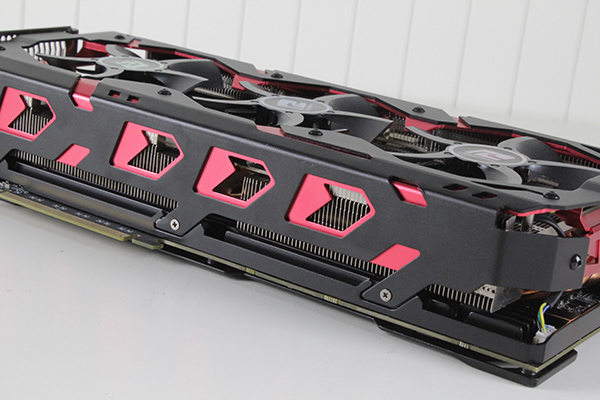
The frame of the cooler also can be removed easily, there is no need to remove the entire cooler.
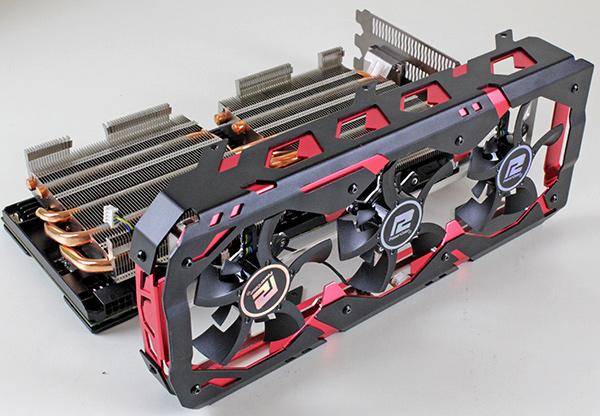
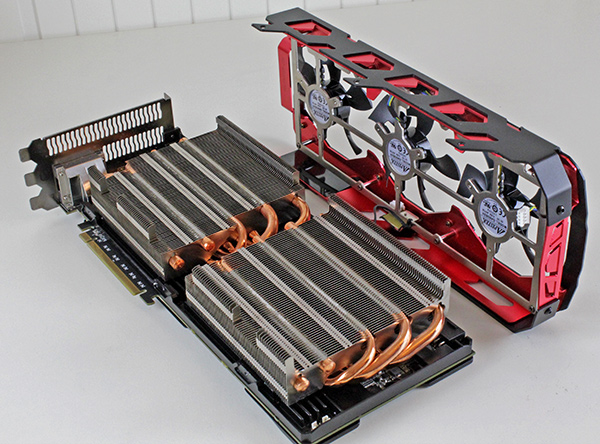
The Devil 13 logo is powered by a 2-pin cable. The cable is very short and needs to be carefully disconnected prior to frame removal.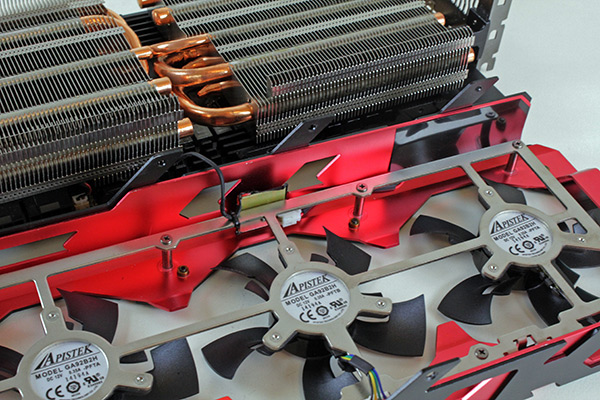
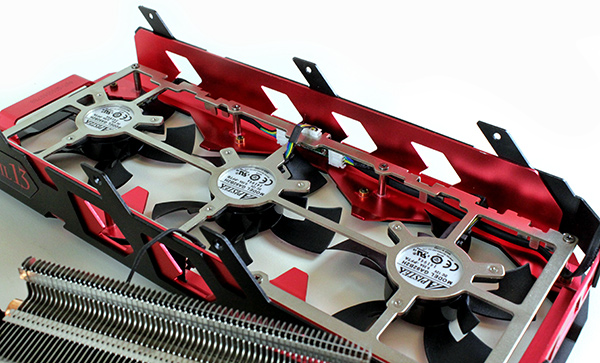
The Cooler Devil 13 HD 7990 was a triple-slot card, too. However, the third slot only housed the fans. The Devil 13 R9 290X has a slightly bigger heatsink which reaches the third slot. EVGA uses a similar design approach with its ACX cooler.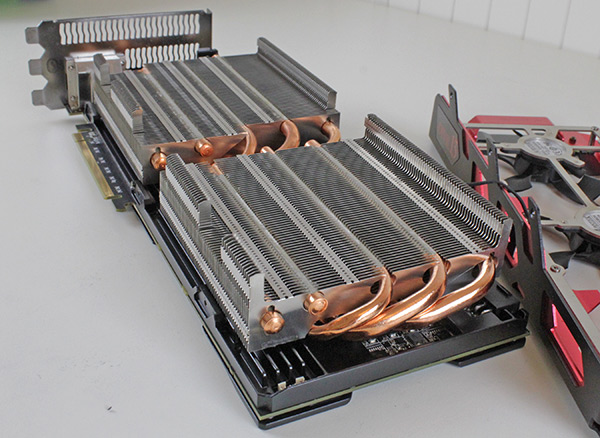
Since this is a very expensive card, we expected a somewhat better finish. Parts of the heatsink feel sensitive and it is easy to twist a few fins while removing the cooler frame.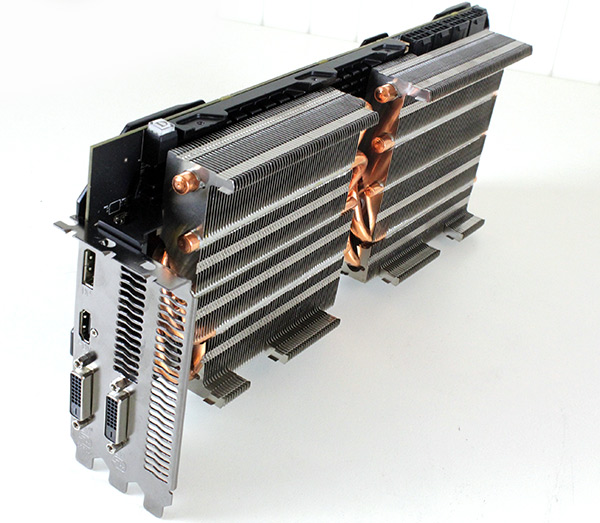
The heat dissipation system employs a total of ten heatpipes. It is comprised of two parts, which is an approach used by both Nvidia and AMD on their previous dual-GPU reference designs. Each GPU is in contact with the copper base of the cooler.
The Devil 13 Dual GPU R9 290X card features two stabilization frames, which a 2.34kg card surely needs. The front of the PCB features a big frame that covers all low profile components such as the memory chips and power components. This frame is screwed to the second frame.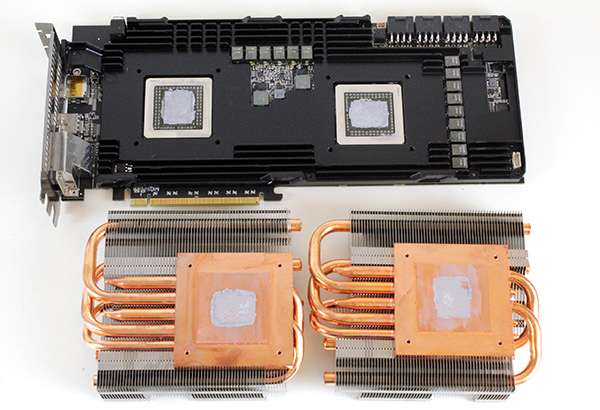
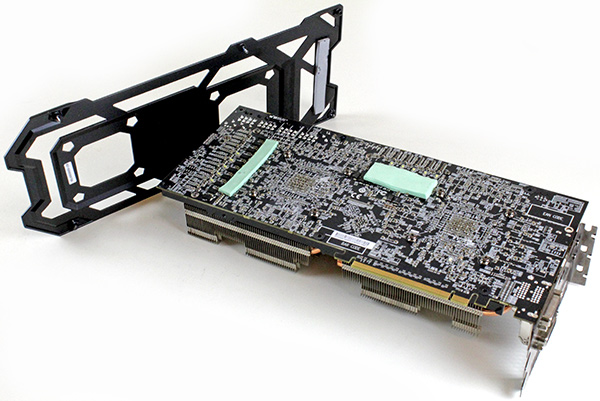
The screws that keep the heatsink attached to the card are on the back of the card. Each of these screws has four washers for a better grip. 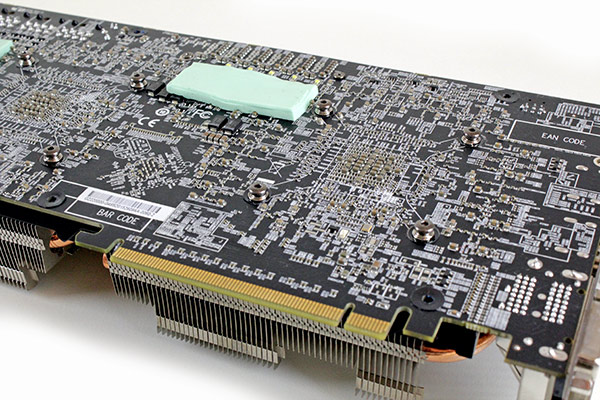
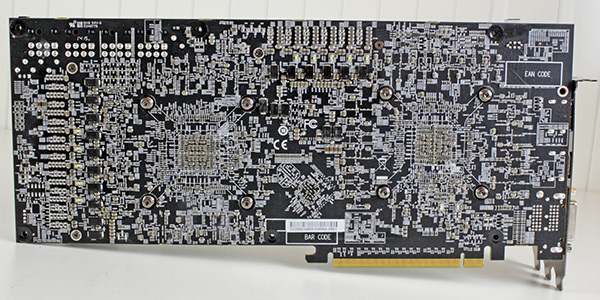
The PCB sports two Hawaii XT graphics processor. The frame also cools the internal bridge (PEX 8747 from PLX) which handles communication between GPUs. The board has a 10+3+2 phase power design and it is built with a Platinum Power Kit.
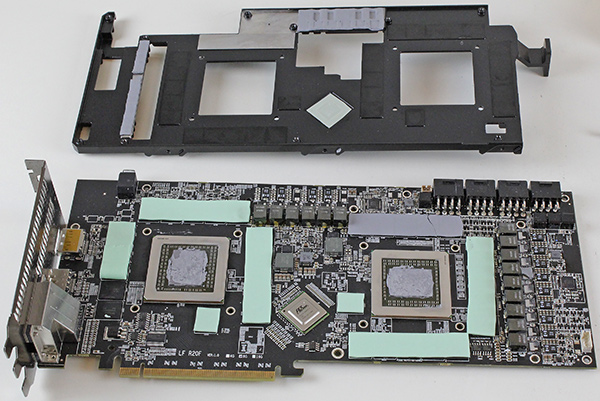
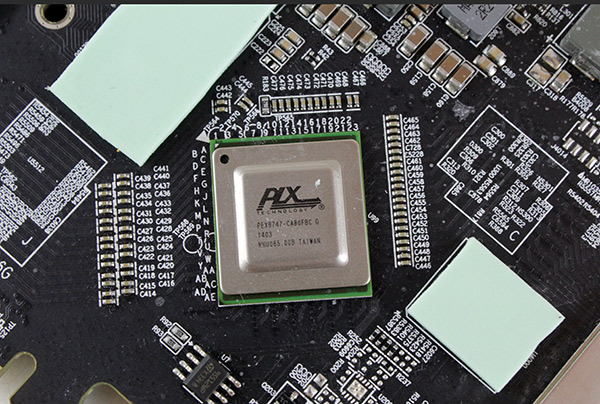
The card packs 8GB of GDDR5, so each GPU has 4GB at its disposal. The memory chips come from Hynix and they run at 1350MHz.
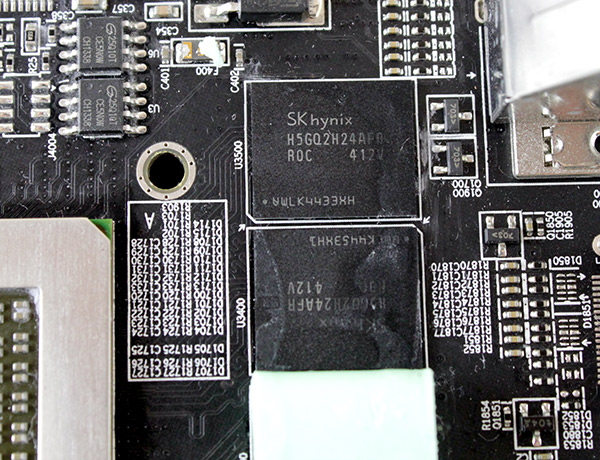
With the launch of the Radeon R9 290/290X/295X2 cards AMD updated Eyefinity to version 2.0. Eyefinity now enables custom multi-monitor resolutions. You can now use any monitor output and use similar monitors to create an Eyefnity setup. It also supports DDR audio. The rest of the R9 290 series cards have similar connector layout, i.e. two DVIs, one standard DisplayPorts and one standard HDMI. Next generation 4K (4096x2160) and UHD (3840x2160) resolutions are supported, too. You can also use any combination of display connectors or use four outputs at the same time. One HDMI 1.4a compatible sound device is built in the GPU, which also includes HD audio and Blu-ray 3D movies support.
With the second BIOS loaded, the Devil 13 Dual GPU R9 290X manages to sustain its clock rate all the time. This is good news, as there are no performance penalties after sustained gaming, which is the case with the Crossfire of the two reference Single GPU R9 290X series cards.
Testbed:
- Motherboard: Intel DZ87KLT-75K
- CPU: Intel Core i7 4770K, 4x3.5GHz (Haswell)
- CPU Cooler: EVGA
- Memory: 2x4GB Corsair DDR3 2400MHz
- Harddisk: Corsair Neutron GTX 240GB
- Case: CoolerMaster Cosmos II
- Operating System: Win8.1 64-bit
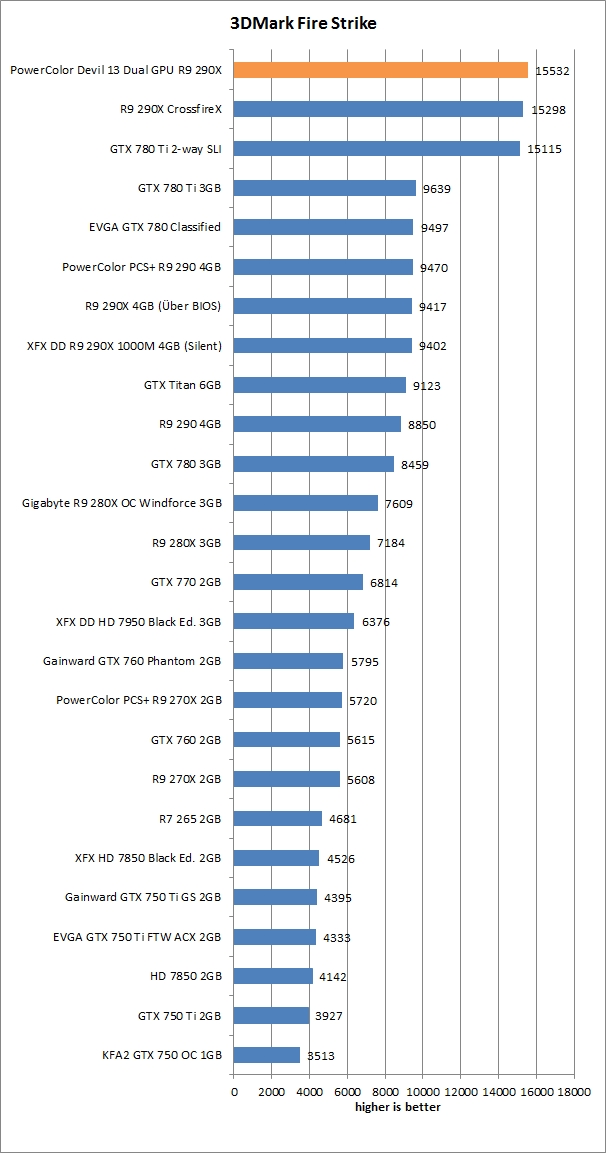
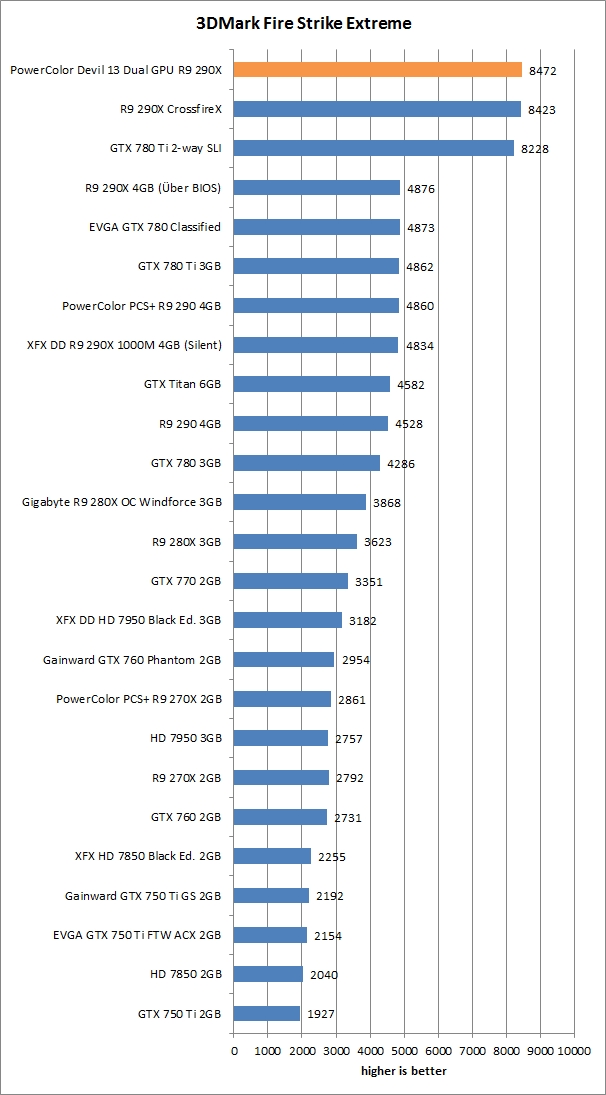


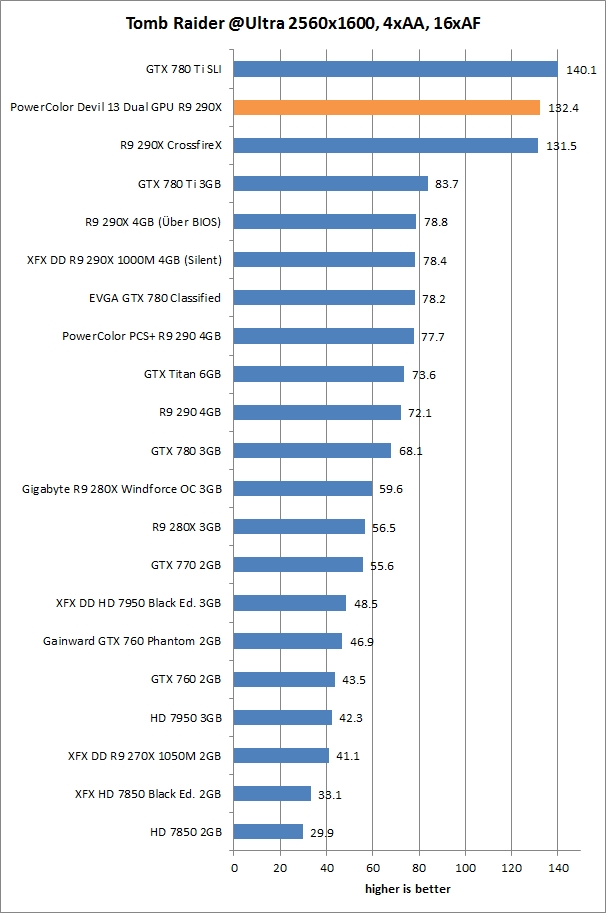
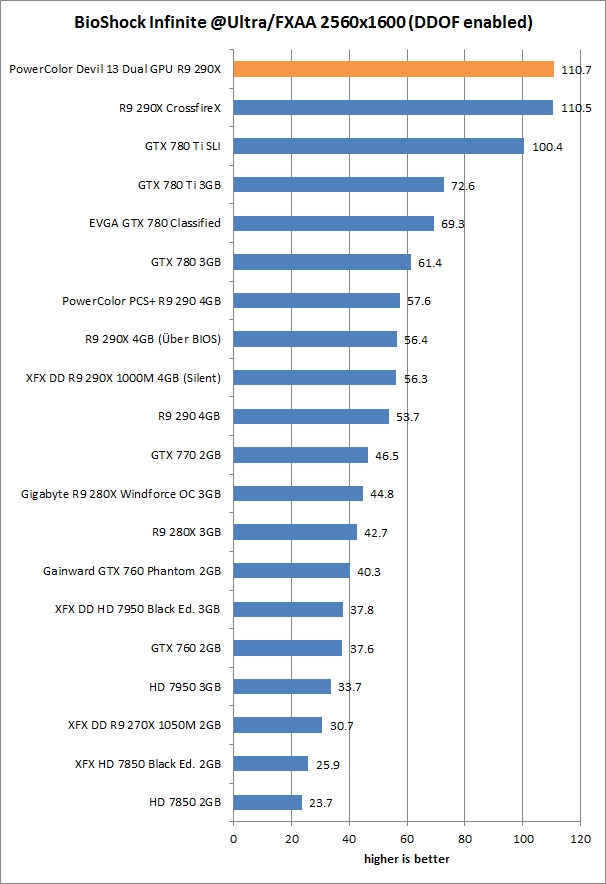
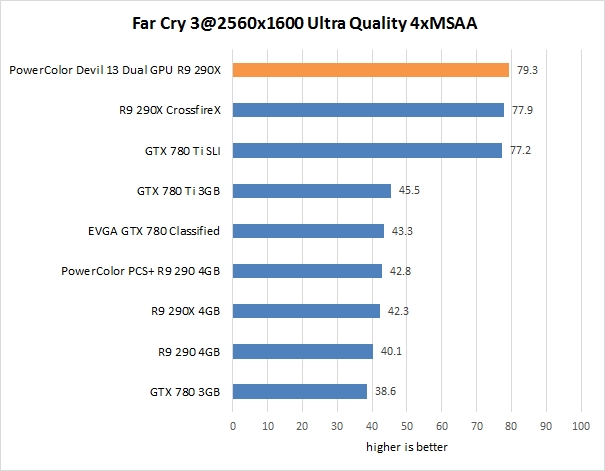
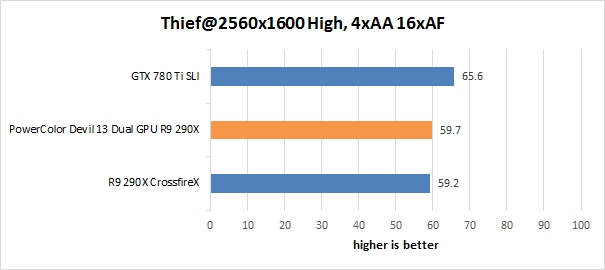
PowerColor is the only AMD partner to develop and market a non-reference R9 295X2 card. The Devil 13 relies on a triple-slot air cooler, while the reference R9 295X2 uses an Asetek water cooler with an external radiator.
The Asetek closed-loop cooler is a dual-slot design. The pump is installed in the cooler itself, while the radiator is designed to fit inside the chassis. This means the Devil 13 is quite a bit easier to install. All it requires is three free slots.
AMD decided to use Asetek’s liquid cooling solution due to the immense TDP of two Hawaii GPUs on a single PCB. The reference cooler does an admirable job and keeps the massive card relatively cool at 75 degrees Celsius.
PowerColor’s cooler deserves a fair bit of praise, too. It manages to keep the GPU cool without the need for a water cooler. The downside is that it ends up a bit louder than the reference cooler. In everyday operations the difference is negligible, but following prolonged periods of full load, the reference water-cooler is noticeably quieter.
The difference is not too big to disqualify the Devil 13. The card ends up a bit louder than the old HD 6990, which is notorious for its loud cooler. In idle mode the Devil 13 is nearly inaudible. When the card idles, only one of the GPUs is active and the temperature hovers around 44C. However, the card heats up as soon as there is load and temperatures hit up to 84 degrees. We measured up to 94 in a small chassis, but this is simply not a realistic figure as few enthusiasts would ever think about installing a dual-GPU card in a small chassis.
The really good news is that the card does not throttle much. The clocks rarely drop below 1000MHz. We did experience some throttling in a small chassis, but in a properly ventilated high-end chassis we did not. Bear in mind that this immensely powerful card can easily heat up all the air inside the chassis, so the chassis has to be well ventilated. On a hot summer day a high-end rig with a 500W can easily heat up a small room and force you to break a sweat, or crank up the air conditioning.
You can manage fan RPM via a number of popular utilities and PowerColor has a special Turbo Mode ‘D’ that enables the user to bump up the fan speed by 20 percent. It can be useful in some situations, namely if you notice the GPU clocks sliding north of 1000MHz. Turbo Mode can easily drop the temperature by 5 degrees, allowing the card to clock back to 1000MHz.
PowerColor used a total of four 8-pin connectors on the Devil 13 Dual GPU R9 290X, which means the card can draw as much as 675W. The card ships with two 6-pin to 8-pin converters. Bear in mind that you need a 900W or 1000W PSU.
The reference R9 295X2 has just two 8-pin connectors and it draws 80W less than the Devil 13. This phenomenon can be explained in more ways than one. It might be down to circuit design, or it could the result of cherry picked chips – AMD could have picked low leakage parts for the R9 295X2. One advantage of getting a Devil 13 is that it you do not have to use a PSU capable of delivering 28A to each 8-pin auxiliary power connector. Most PSUs nowadays ship with a massive 12V rail anyway.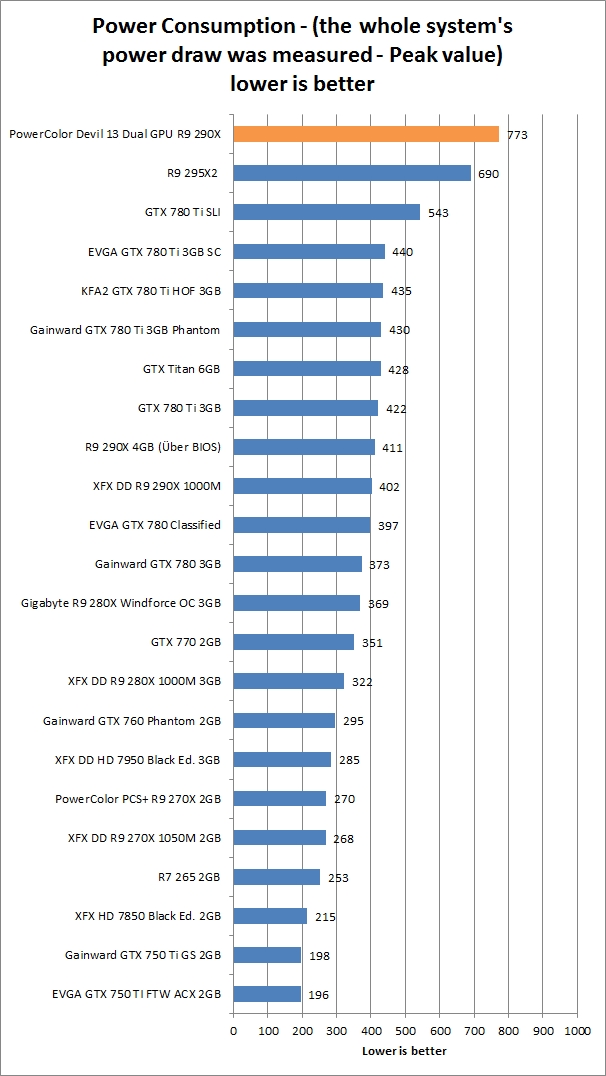
PowerColor has its own overclocking tool dubbed the Powerup Tuner, which offers basic options and allows users to overclock the GPU, memory or manage fan RPM. We loaded the second BIOS since it offers more aggressive AUTO fan management. We had no trouble upping the memory clock from 1350MHz to 1650MHz (effective 6600MHz). The GPU was keen to cooperate and we easily overclocked it to 1090MHz by using +40 adjustment to the PowerTarget settings.With fans at 100% we did not notice clock speed throttling. After our overclock the system used 100W more power. Battlefield 4 yielded a 6% performance gain.
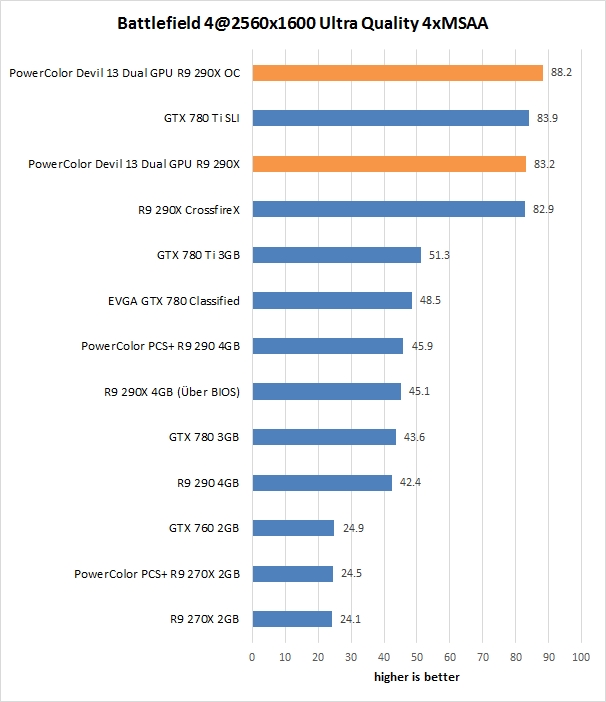
With the Devil 13 Dual GPU R9 290X PowerColor did what other AIBs did not dare do – it came up with a non-reference dual Hawaii card. This fact alone is worthy of some praise.
AMD used liquid cooling on the reference card and it has a slight edge when it comes to noise and thermals. However, PowerColor’s cooler also performs admirably. Performance is very similar, but the fan is louder.
As for gaming performance, the difference between the Devil 13 and the 18MHz faster reference card is negligible. Both cards are capable of running any game with maxed out details at 2560x1600 and they can even cope with UHD/4K resolutions.
After a lot of complaints about frame pacing issues on AMD’s previous dual-GPU cards, the company finally managed to win back the trust of diehard gamers with polished and stable R9 295X2 drivers.
At the end of the day it all boils down to personal preference, whether you want a triple slot air cooler card or a dual-slot card with water cooling.
Power Color’s R9 295X2 costs around €1230, which a bit more than two GTX 780 Ti cards. The PowerColor Devil 13 Dual GPU card is not easy to find in European retail and therefore it is quite a bit pricier than the reference card. On average you are looking at about €1,400 in Europe, but the price should drop as the card becomes widely available. However, in terms of value it is still an interesting proposition. The card ships with a bundled Razer Ouroboros gaming mouse, which costs about €130 on its own. That makes the price tag a bit easier to swallow.
For those who can afford it, the Devil 13 will deliver second to none performance, but as always the sad truth is that most gamers simply cannot afford dual-GPU flagships.



